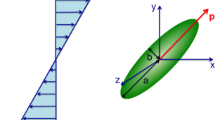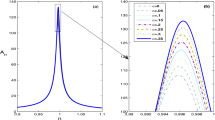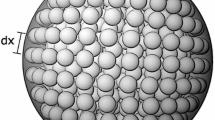Abstract
A simulation algorithm was developed to predict the rheological properties of oblate spheroidal suspensions. The motion of each particle is described by Jeffery’s solution, which is then modified by the interactions between the particles. The interactions are considered to be short range and are described by results from lubrication theory and by approximating locally the spheroid surface by an equivalent spherical surface. The simulation is first tested on a sphere suspension, results are compared with known experimental and numerical data, and good agreement is found. Results are then presented for suspensions of oblate spheroids of two mean aspect ratios of 0.3 and 0.2. Results for the relative viscosity η r, normal stress differences N 1 and N 2 are reported and compared with the few available results on oblate particle suspensions in a hydrodynamic regime. Evolution of the orientation of the particles is also observed, and a clear alignment with the flow is found to occur after a transient period. A change of sign of N 1 from negative to positive as the particle concentration is increased is observed. This phenomenon is more significant as the particle aspect ratio increases. It is believed to arise from a change in the suspension microstructure as the particle alignment increases.












Similar content being viewed by others
References
Anczurowski E, Mason SG (1967) The kinetics of flowing dispersions III. Equilibrium orientation of rods and discs (experimental). J Colloid Interface Sci 23:533–546
Ausias G, Fan XJ, Tanner RI (2006) Direct simulation for concentrated fiber suspensions in transient and steady state shear flows. J Non-Newton Fluid Mech 135:46–57
Ball RC, Melrose JR (1997) A simulation technique for many spheres in quasi-static motion under frame-invariant pair drag and Brownian forces. Physica A 247:444–472
Bartok W, Mason SG (1957) Particle motions in sheared suspensions, part 5: rigid rods and collision doublets of spheres. J Colloid Sci 12:243–262
Batchelor GK (1970) The stress system I na suspension of force-free particles. J Fluid Mech 41(3):545–570
Boek ES, Coverney PV, Lekkerkerker HNW, Van der Schoot P (1997) Simulating the rheology of dense colloidal suspension using dissipative particle dynamics. Phys Rev E 55(3):3124–3133
Bossis G, Brady JF (1984) Dynamic simulation of sheared suspensions. I. General method. J Chem Phys 80:5141–5154
Brady JF, Bossis G (1988) Stokesian dynamics. Ann Rev Fluid Mech 20:111–157
Brown ABD, Rennie AR (2000) Monodisperse colloidal plates under shear. Phys Rev E 62(1):851–862
Claeys IL, Brady JF (1993) Suspensions of prolate spheroids in Stokes flow. J Fluid Mech 251:411–500
Cox RG (1973) The motion of suspended particles almost in contact. Int J Multiphase Flow 1:343–371
Einstein A (1906) Eine neue bestimmung der molekuldimension. Ann Phys 19:289–306
Einstein A (1911) Berichtigung zu meiner arbeit: eine neue bestimmung der molekuldimension. Ann Phys 34:591–592
Elliot JA, Windle AH (2000) A dissipative particle dynamics method for modeling the geometrical packing of filler particles in polymer composites. J Chem Phys 113:10367–10376
Fan XJ (2006) Numerical study on some rheological problems of fiber suspensions. PhD thesis, The University of Sydney
Fan XJ, Phan-Thien N (1997) Completed double layer boundary element method for periodic suspension. ZAMP 48:1–12
Folgar FP, Tucker CL (1984) Orientation behavior of fibers in concentrated suspensions. J Reinf Plast Compos 3:98–119
Foss DR, Brady JF (2000) Structure, diffusion and rheology of Brownian suspensions by Stokesian dynamics simulation. J Fluid Mech 407:167–200
Gauthier F, Goldsmith HL, Mason SG (1971) Particle motions in non-Newtonian media I. Couette flow. Rheol Acta 10:344–364
Goldsmith HL, Mason SG (1962) The flow of suspensions through tubes I. Single spheres, rods and discs. J Colloid Sci 17:448–476
Grmela M, Ottinger HC (1997) Dynamics and thermodynamics of complex fluids. I. Development of a general formalism. Phys Rev E 55:6620–6632
Hinch EJ, Leal LG (1972) The effect of Brownian motion on the rheological properties of a suspension of non-spherical particles. J Fluid Mech 52:683–712
Hoogerbrugge PJ, Koelman JMVA (1992) Simulating microscopic hydrodynamic phenomena with dissipative particle dynamics. Europhys Lett 19:155–160
Huilgol RR, Phan-Thien N (1997) Fluid mechanics of viscoelasticity. Elsevier, Amsterdam
Iso Y, Cohen C, Koch DL (1996) Orientation in simple shear flow of semi-dilute fiber suspensions: 2. highly elastic fluids. J Non-Newton Fluid Mech 62:135–153
Jeffery GB (1922) The motion of ellipsoidal particles immersed in a viscous fluid. Proc Roy Soc A102:161–179
Jongschaap RJJ (1987) On the derivation of some fundamental expressions for the average stress tensor in systems of interaction particles. Rheol Acta 26:328–337
Karnis A, Goldsmith H, Mason SG (1966a) The kinetics of flowing dispersions. Part 1. Concentrated suspensions of rigid particles. J Colloid Interface Sci 22:531–553
Karnis A, Goldsmith H, Mason SG (1966b) Particle motions in sheared suspension. Part 5. Inertial effects. Can J Chem Eng 44:181–193
Kim S, Karrila SJ (1991) Microhydrodynamics: principles and selected applications. Butterworth-Heinemann, Boston
Ladd AJC (1990) Hydrodynamic transport coefficients of random dispersions of hard spheres. J Chem Phys 93(5):3484–3494
Lees AW, Edwards SF (1972) The computer study of transport processes under extreme conditions. J Phys C 5:1921–1929
Letwimolnun W, Vergnes B, Ausias G, Carreau PJ (2007) Stress overshoots of organoclay nanocomposites in transient shear flow. J Non-Newton Fluid Mech 141:167–179
Meng Q, Higdon J (2008a) Large scale dynamic simulation of plate-like particle suspensions. Part II: Brownian simulation. J Rheol 52(1):1–36
Meng Q, Higdon J (2008b) Large scale dynamic simulation of plate-like particle suspensions. Part I: non-Brownian simulation. J Rheol 52(1):37–65
Moan M, Aubry T, Bossard F (2003) Nonlinear behavior of very concentrated suspensions of plate-like kaolin particles in shear flow. J Rheol 47(6):1493–1504
Mody N, King MR (2005) Three-dimensional simulations of a platelet-shaped spheroid near a wall in shear flow. Phys Fluids 17(113302):1–12
Nasseri S, Phan-Thien N, Fan XJ (2000) Lubrication approximation in completed double layer boundary element method. Comput Mech 26:388–397
Pozrikidis C (2006) Interception of two spheroidal particles in shear flow. J Non-Newton Fluid Mech 136(1):50–63
Qi F (2000) Effective properties of particulate solids and suspensions. PhD thesis, The University of Sydney
Qi D, Luo L (2002) Transitions in rotations of a non-spherical particle in a three-dimensional moderate Reynolds number Couette flow. Phys Fluids 14(12):4440–4443
Rajabian M, Beheshty MH (2008) Rheology and flow behavior of suspensions of nanosized plate-like particles in polyester resins at the startup of shear flows; experimental and modelling. Polym Compos 1–9. doi:10.1002/pc
Rimon E, Boyd SP (1997) Obstacle collision detection using best ellipsoid fit. J Intell Robot Syst 18:105–126
Sierou A, Brady JF (2002) Rheology and microstructure in concentrated noncolloidal suspensions. J Rheol 46(5):1031–1056
Shenoy AV (1999) Rheology of filled polymer systems. Kluwer, Dordrecht, ISBN 0-412-83100-7
Silbert LE, Melrose JR, Ball RC (1997) Colloidal microdynamics: pair-drag simulations of model-concentrated aggregated systems. Phys Rev E 56(6):7067–7077
Singh AP, Rey AD (1998) Microstructure constitutive equation for discotic nematics liquid nematics crystalline materials—part II. Microstructure-rheology relations. Rheol Acta 37:374–386
Singh A, Nott PR (2000) Normal stresses and microstructure in bounded sheared suspensions via Stokesian dynamics simulations. J Fluid Mech 412:279–301
Singh A, Nott PR (2003) Experimental measurements of the normal stresses in sheared Stokesian suspension. J Fluid Mech 490:293–320
Sundararajakumar RR, Koch DL (1997) Structure and properties of sheared fiber suspensions with mechanical contacts. J Non-Newton Fluid Mech 73:205–239
Tanner RI (2000) Engineering rheology. Oxford University Press, Oxford
Taylor GI (1923) The motion of ellipsoidal particles in a viscous fluid. Proc Roy Soc A103:58–61
Thomas DG (1965) Transport characteristics of suspension: VIII a note on the viscosity of Newtonian suspensions of uniform spherical particles. J Colloid Sci 20:267–277
Yamamoto S, Matsuoka T (1997) Dynamic simulation of a platelike particle dispersed system. J Chem Phys 107(8):3300–3308
Yamamoto T, Suga T, Mori N (2005) Brownian dynamics simulation of orientational behavior, flow-induced structure, and rheological properties of a suspension of oblate spheroid particles under simple shear. Phys Rev E 72(021509):1–11
Yamane Y, Kaneda Y, Dio M (1994) Numerical simulation of semi-dilute suspensions of rod-like particles in shear flow. J Non-Newton Fluid Mech 54:405–421
Yu Z, Phan-Thien N, Tanner RI (2007) Rotation of a spheroid in a Couette flow at moderate Reynolds numbers. Phys Rev E 76(026310):1–11
Yziquel F, Carreau PJ, Moan M, Tanguy P (1999) Rheological modelling of concentrated colloidal suspension. J Non-Newton Fluid Mech 86:133–155
Zarraga IE, Hill DA, Leighton DT Jr (2001) Normal stresses and free surface deformation in concentrated suspensions of noncolloidal spheres in a viscoelastic fluid. J Rheol 45(5):1065–1084
Acknowledgements
This work is supported by the Cooperative Research Center for Polymers. We also thank Dr Gilles Ausias for our useful discussions on the topic of particle suspensions.
Author information
Authors and Affiliations
Corresponding author
Appendix 1: Comparison between the local sphere approximation and Cox’s results
Appendix 1: Comparison between the local sphere approximation and Cox’s results
We have estimated the difference between the values of the short-range hydrodynamic interactions obtained by our approximate method with results given by Cox (1973) who derived solutions for the resistance functions between two surfaces separated by a viscous fluid at small distance. In Cox’s work, similar to our assumption, the local curvature is characterized by two principal radii of curvature on each surface which can be given by r m and r t, the meridional and transverse radii. The angular orientation θ (Fig. 13) between each surface principal direction about the surface normal is also specified and Cox’s results are given depending on θ. This orientation is not the relative orientation between the particles defined below but simply the relative orientation between the principal radii of each surface. Since our approximation does not account for that relative orientation, results for different relative orientation are calculated with Cox’s method for comparison.
To obtain an estimate of the error introduced by approximating the surfaces by equivalent sphere, the characteristics of the interacting surfaces were sampled during a simulation for a 20% suspension of oblate spheroids of aspect ratio a r = 0.2. Information such as particle orientations, local surface curvatures, and interparticle distances and velocities were recorded and grouped depending on the particle relative orientations. Indeed, for similar relative orientations, pairs of particles should show similar interacting surfaces characteristics and this facilitates the estimation of the error introduced by the local-sphere approximation. The particle relative orientation is given by α = cos − 1 (pp), where pp is the inner product of p the spheroidal particle orientation vector and eighteen groups were created covering a range of relative orientation from 0° to 90° with intervals of 5°.
As observed in the results presented in “Orientation tensor,” a suspension of oblate spheroidal particles shows a strong particle alignment when subject to a shear flow. It is possible to observe the distribution g(α) of the relative orientation α of particle pairs as shown on Fig. 14, where a large fraction of the particles shows alignment.
For each particle-relative orientation group, we use the average interacting surface characteristics to compute the lubrication forces and torques given by the approximate sphere method and those given by Cox. Since Cox’s results depend on the principal radii relative orientation θ, lubrication interactions are calculated for angles θ = 0°, 45°, and 90°. The values found at θ = 45° are found to always be between those found at θ = 0° and 90° which are angles where the minimum and maximum errors given in the total error (Table 5) are found. Once the error for a particle relative orientation group is estimated, it is weighted by the corresponding value of the distribution function g(α) to account for the probability of this particle relative orientation to be found. For a representative estimation of the error on the global behavior of the suspension, the errors are also scaled by the maximum force found in the suspension. It was observed that as the particle relative orientation angle α increases, so does the error, but since the probability to find such orientation decreases as well as the lubrication forces between such surfaces (decrease of the surface radii of curvature), the relative error decreases.
Using the comparison method detailed above, the errors found for the normal and tangential lubrication forces and torques on the particles are estimated to be respectively 4.866%, 0.394%, and 2.098%.
Rights and permissions
About this article
Cite this article
Bertevas, E., Fan, X. & Tanner, R.I. Simulation of the rheological properties of suspensions of oblate spheroidal particles in a Newtonian fluid. Rheol Acta 49, 53–73 (2010). https://doi.org/10.1007/s00397-009-0390-8
Received:
Accepted:
Published:
Issue Date:
DOI: https://doi.org/10.1007/s00397-009-0390-8






